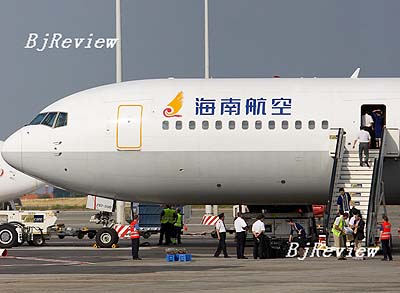|

Although China's aviation regulator disagrees that the current top three state-owned airlines should merge, the possibility of mergers among China's major airlines still exists.
Cai Jianjiang, Chief Executive Officer of Air China, said on many occasions that the possibility of merging with other domestic airlines such as China Southern Airlines has not been ruled out.
Cai said that with the opening-up of the aviation industry the increasingly fierce competition have forced Air China to consider mergers with other domestic airlines.
It has been reported that under the supervision of the State Assets Supervision and Administration Commission of the State Council (SASAC), Air China could merge with Shenzhen Airlines, Shanghai Airlines and Hainan Airlines. Air China, China Southern Airlines and China Eastern Airlines are the three largest airlines in China.
However, Yang Yuanyuan, Director General of the Civil Aviation Administration of China (CAAC), has dissented. He opposed the idea of merging the three top airlines because it would reduce competition.
Since the top three airlines are state-owned, CAAC only manages the aviation operation of these airline companies. Therefore, SASAC calls the shots in determining any merger or acquisition activities regarding these airlines.
When SASAC was established in 2003, major restructuring of the industry was implemented, with less than 20 airlines surviving. Currently, there are 13 airlines mainly providing passenger services and the rest are mostly cargo airlines.
Last December, SASAC issued guidelines directing the restructuring of state-owned assets and enterprises, noting that by 2010, the number of Central Government-controlled enterprises should be restructured to about 80-100 from 158, with 30-50 of them transformed into larger companies through mergers and acquisitions.
According to SASAC officials, the aviation industry is one of the focuses of this round of restructuring.
Competitive pressures
With the gradual opening of the domestic aviation market, airlines have been able to secure access to more mainland routes and expand their operations.
An aviation agreement inked at the second-round China-U.S. Strategic Economic Dialogue will double the number of passenger flights between the two countries by 2012. China will abandon all restrictions on U.S. passenger and cargo flights in terms of routes and the number of flights by 2011.
Liu Shaoyong, Chairman of China Southern Airlines, said that with the deepening of economic globalization and the liberalization of aviation transportation, the global aviation industry will be greeted with a new round of mergers and acquisitions, which will greatly influence China's aviation industry.
Li Jiaxiang, Chairman of Air China, said that the introduction of foreign airlines poses serious problems for domestic airlines. He said the development trend of the aviation industry is fewer airlines through industrial restructuring.
Huang Bin, Secretary of Board of Directors of Air China, argued that the new round of restructuring would greatly differ from that in 2003. This time, market-oriented measures would be preferred.
Potential mergers
The SASAC has a plan that every industry should have one or two big multinational companies. Among the three biggest airlines, Air China has the possibility of remaining and merging other airlines into its operations. Either China Southern Airlines or China Eastern Airlines could possibly be merged. Yet, China Eastern Airlines has already introduced Singapore Airlines as one of its shareholders. Therefore, it is widely expected that China Southern Airlines will merge with Air China.
Apart from the major three airlines, other aviation companies also face reorganization.
But these mergers will not be an easy job. Some aviation companies have opposed the idea of mergers and acquisitions. Chen Feng, Chairman of Hainan Airlines, said on October 19, "Although too many small airlines are not good, it is still impossible to have a super large airline company." Chen said he had not received any orders to restructure and has no intention of acquiring other small airlines.
Hainan Airlines is privately owned and ranks fourth by assets. Together with the big three state-owned airlines, the four hold 90 percent of the domestic civil aviation market.
| 